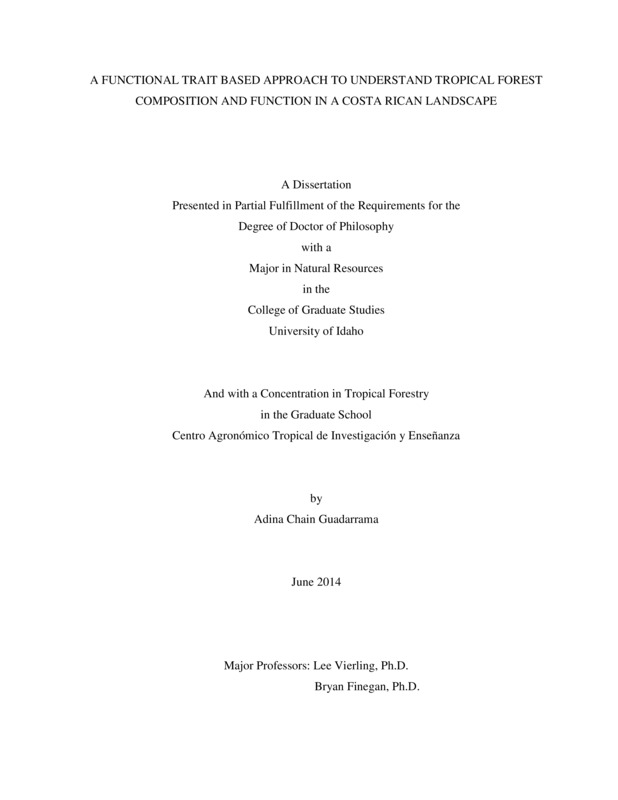A FUNCTIONAL TRAIT BASED APPROACH TO UNDERSTAND TROPICAL FOREST COMPOSITION AND FUNCTION IN A COSTA RICAN LANDSCAPE
Chain Guadarrama, Adina. (2014). A FUNCTIONAL TRAIT BASED APPROACH TO UNDERSTAND TROPICAL FOREST COMPOSITION AND FUNCTION IN A COSTA RICAN LANDSCAPE. Theses and Dissertations Collection, University of Idaho Library Digital Collections. https://www.lib.uidaho.edu/digital/etd/items/chainguadarrama_idaho_0089e_10357.html
- Title:
- A FUNCTIONAL TRAIT BASED APPROACH TO UNDERSTAND TROPICAL FOREST COMPOSITION AND FUNCTION IN A COSTA RICAN LANDSCAPE
- Author:
- Chain Guadarrama, Adina
- Date:
- 2014
- Keywords:
- Climate change Community assembly Ecosystem functioning Functional traits Neotropical forests Trees
- Program:
- Natural Resources
- Subject Category:
- Ecology
- Abstract:
-
Quantifying the factors driving tropical forest composition, structure and function is a continuous area of ecological research. Recently, novel approaches have enabled research questions on this topic to be addressed not only using a taxonomic approach (species identity and abundance), but through the characterization of the collection of species functional traits present within plant communities. This functional trait approach is powerful because traits are directly linked to the performance of species in their environment, determining how they use limiting resources, limiting their geographic range and areas of distribution, and determining ecosystem processes and services delivered to humans.
The research reported here follows this functional approach. Located within the San Juan La Selva Region in northern Costa Rica, the study landscape encompasses 6,166 km2 across edaphic, climatic and elevation gradients. Using species abundance and six functional traits from more than 250 species of dominant canopy trees and palms in 127 old-growth forest plots, we sought to (i) better understand the underlying factors determining the assembly processes of old-growth forest communities, (ii) assess current and future spatial distributions of community functional properties, and (iii) quantify relationships between forest canopy functional characteristics and hydrologic processes.
This work highlights the value of using functional traits to assess community assembly. In particular, we demonstrate through the use of functional traits the role that niche assembly mechanisms play in the community composition of old-growth forest communities along edaphic and climatic gradients. Moreover, by building response models of community traits values to climate variables, we predict community functional properties under current and future scenarios of climate change, discussing the consequences that the observed reduction in functional area occupied by these forest communities could have on ecosystem function. Finally this research demonstrated that particular functional elements of lowland forest canopies influence the spatial redistribution of rainfall. Therefore, future shifts in species and functional group composition could potentially change the hydrological cycle in these ecosystems. Our ability to accurately assess vegetation responses to environment and predict composition changes in tropical landscapes undergoing continuous transformation derived by human activities is relevant to finding appropriate conservation approaches of remnant forest fragments.
- Description:
- doctoral, Ph.D., Natural Resources -- University of Idaho - College of Graduate Studies, 2014
- Major Professor:
- Vierling, Lee A; Finegan, Bryan
- Committee:
- Casanoves, Fernando; Kavanagh, Kathleen; DeClerck, Fabrice
- Defense Date:
- 2014
- Identifier:
- ChainGuadarrama_idaho_0089E_10357
- Type:
- Text
- Format Original:
- Format:
- application/pdf
- Rights:
- In Copyright - Educational Use Permitted. For more information, please contact University of Idaho Library Special Collections and Archives Department at libspec@uidaho.edu.
- Standardized Rights:
- http://rightsstatements.org/vocab/InC-EDU/1.0/

